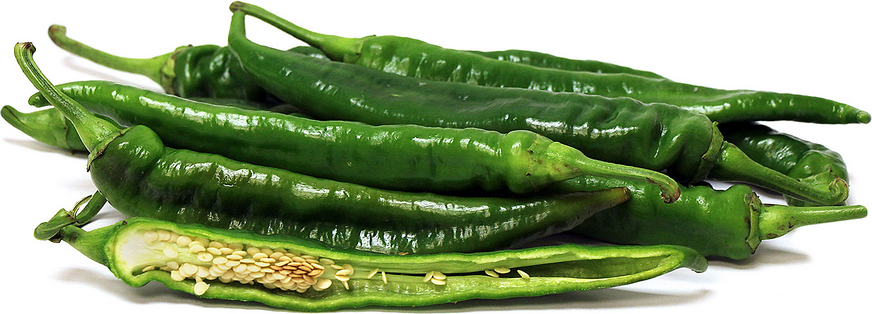


Piment d' Anglet Chile Peppers
Estimated Inventory, lb : 0
Description/Taste
Piment d' Anglet chile peppers are elongated pods, averaging 15 to 20 centimeters in length with the ability to grow up to 30 centimeters, and have a conical shape that tapers to a point on the non-stem end. The pods can be straight, curved, to heavily twisted, and the skin is glossy, rippled, tender, and firm, ripening from dark green to red when mature. Underneath the surface, the flesh is lightly striated, crisp, and pale green to red depending on maturity, encasing a narrow, central cavity filled with round and flat, cream-colored seeds. Piment d' Anglet chile peppers have a fresh, vegetal flavor with a distinct peppery taste when young and green. If left to mature, the red version of the pepper develops a sweeter, fruity flavor, and does not contain any heat.
Seasons/Availability
Piment d' Anglet chile peppers are available in the summer.
Current Facts
Piment d' Anglet chile peppers, botanically classified as Capsicum annuum, are a long and sweet variety that belongs to the Solanaceae or nightshade family. Also known as Doux des Landes, Chiparras chile, Piment Basque chile peppers, and Basque Fryer peppers, Piment d’ Anglet chile peppers are native to the Basque region of Spain and France, which is a region known for its innovative, versatile cuisine and highly-flavored peppers. Similar to Italian frying peppers, Piment d’ Anglet chile peppers are not commercially grown, but they are a popular variety amongst sweet pepper enthusiasts and are commonly cultivated in home gardens for use as an everyday pepper.
Nutritional Value
Piment d’ Anglet chile peppers are an excellent source of vitamins A and C, which are antioxidants that can help boost collagen production and prevent vision loss. The peppers also contain iron, vitamins B6 and K, potassium, and fiber.
Applications
Piment d' Anglet chile peppers are best suited for both raw and cooked applications such as sautéing, braising, roasting, grilling, and baking. The peppers can be used in their young, green state and also in their mature, red state and can be consumed fresh, out-of-hand, chopped into salads, or used as a vessel for dips on appetizer plates. The peppers can also be stuffed with grains, meats, or cheeses, tossed into soups and stews, or pickled and preserved in oil. In the Basque region of Spain and France, Piment d’ Anglet chile peppers are a popular frying pepper that is blistered in olive oil and served simply with sea salt. The blistered peppers can also be layered in sandwiches, tossed into salads, topped over pizzas, cooked into omelets, or mixed into paella. Piment d’ Anglet chile peppers pair well with balsamic vinegar, citrus, olive oil, cheeses such as manchego, goat, and parmesan, meats such as chorizo, ham, duck, beef, poultry, tuna, and salted cod, shellfish, eggs, onions, tomatoes, mushrooms, green beans, apples, and dark chocolate. Fresh peppers will keep 1-2 weeks when loosely stored whole and unwashed in a paper or plastic bag in the refrigerator.
Ethnic/Cultural Info
Piment d' Anglet chile peppers are an essential ingredient in the cuisine of the Basque region of Spain and France. The region is similar in size to Rhode Island and consists of coastline, mountains, and grass-filled valleys, which contributes to a very diverse cuisine filled with locally sourced ingredients. The Basque region is also home to six different varieties of peppers that are incorporated into daily cooking. Piment d’ Anglet chile peppers are a classic ingredient in the popular Basque dish piperade, which is a sauce made from garlic, onions, tomatoes, and the sweet peppers. This sauce is traditionally served over eggs for breakfast and is also used as a pasta sauce or served with cured ham, fish, and other grilled meats.
Geography/History
Piment d’ Anglet chile peppers are descendants of original pepper varieties that were native to Central and South America. The peppers were introduced to Europe and Asia via Spanish and Portuguese explorers in the 15th and 16th centuries, and with their introduction, the plants began to be cultivated for specific characteristics, developing new varieties such as the Piment d’ Anglet. The sweet-flavored variety has been cultivated in Landes, a town in the Southwest of France for over a century, and it is also found in the Basque region of Spain and France. Today the peppers are still localized to markets and home gardens in the Basque and Landes regions, but they are also found through small farms and online seed catalogs in the United States and Europe.




